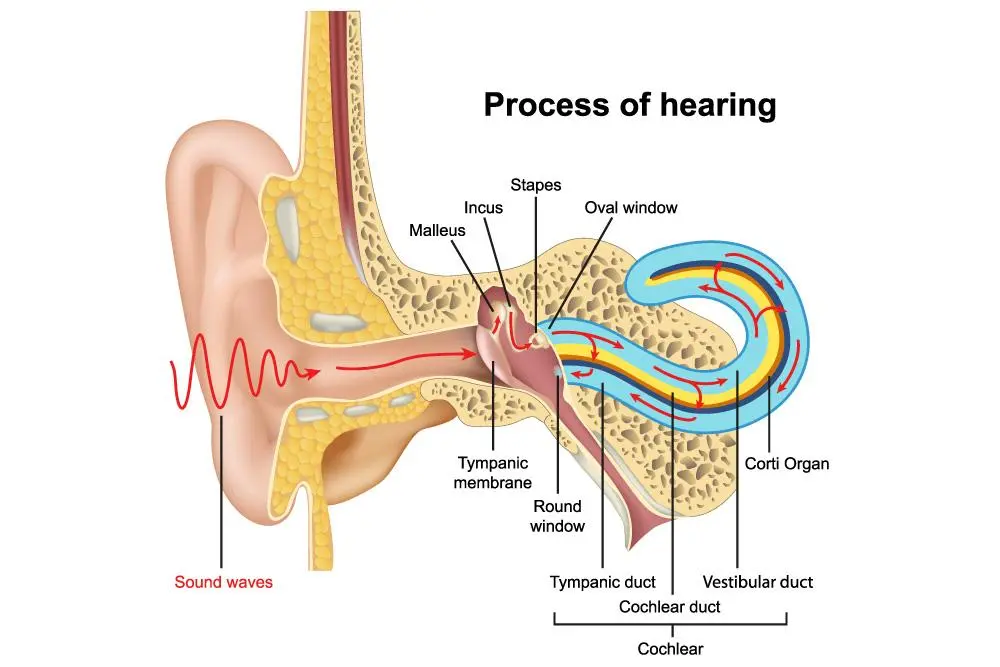Otosclerosis Treatment in Dallas, Fort Worth and Frisco, TX
Otosclerosis is a disease of the middle ear bones and sometimes the inner ear. Otosclerosis is a common cause of hearing impairment and is rarely hereditary.
How Does a “Normal” Ear Function?
The ear is divided into three parts; the external ear, the middle ear, and the inner ear. The external ear collects sound, the middle ear mechanism transforms the sound and the inner ear receives and transmits the sound.
Sound vibrations enter the ear canal and cause the eardrum to vibrate. Movements of the eardrum are transmitted across the middle ear to the inner ear fluids by three small ear bones. These middle ear bones (hammer or malleus, anvil or incus and stirrup or stapes) act as a transformer changing sound vibrations in air into fluid waves in the inner ear. The fluid waves stimulate delicate nerve endings in the hearing canals. Electrical impulses are transmitted on the nerve to the brain where they are interpreted as understandable sound.

What Are the Types of Hearing Impairment?
The external ear and the middle ear conduct sound; the inner ear receives it. If there is some difficulty in the external or middle ear, a conductive hearing impairment occurs. If the trouble lies in the inner ear, a sensorineural or nerve hearing impairment is the result. When there is difficulty in both the middle and the inner ear a mixed or combined impairment exists. Mixed impairments are common in otosclerosis.

Hearing Impairment from Otosclerosis
Stapedial Otosclerosis
Usually otosclerosis spreads to the stapes or stirrup bone, the final link in the middle ear transformer chain. The stapes rests in the small groove, the oval window, in intimate contact with the inner ear fluids. Anything that interferes with its motion results in a conductive hearing impairment. This type of impairment is called stapedial otosclerosis and is usually correctable by surgery. The amount of hearing loss due to involvement of the stapes and the degree of nerve impairment present can be determined only by audiometric examination (hearing tests).
Cochlear Otosclerosis
When otosclerosis spreads to the inner ear a sensorineural hearing impairment may result due to interference with the nerve function. This nerve impairment is called cochlear otosclerosis and once it develops it may be permanent. On occasion the otosclerosis may spread to the balance canals and may cause episodes of unsteadiness.
Dedicated to the Diagnosis and Treatment of Otosclerosis
Otosclerosis is an inherited condition affecting approximately 10% of the population and is caused by the accumulation of abnormal bone growth on the smallest of the three hearing bones—the tiny stirrup-shaped bone called the stapes. The stapes is the third hearing bone, and its motion on the footplate of the inner ear moves the fluid within the inner ear and allows us to hear. The over-growth of bone associated with otosclerosis may cause the stapes bone to become fixed, thus restricting its motion and resulting in hearing loss. This process may affect one or both ears. Symptoms of otosclerosis usually begin in the late teens or early twenties, though it may present later in life. Symptoms usually develop gradually. When otosclerosis causes the stapes bone to be fixed, a “conductive” type of hearing loss—due to poor motion of the hearing bones—occurs. This is a correctable type of hearing loss. Otosclerosis can also cause a “nerve” type of hearing loss due to the release of chemicals into the inner ear fluids. This may increase ringing in the ear known as tinnitus. A combination of these two types of hearing loss is possible, as well. The specific type of hearing loss will dictate management options and can be determined by detailed hearing tests.

